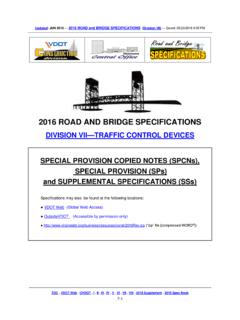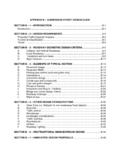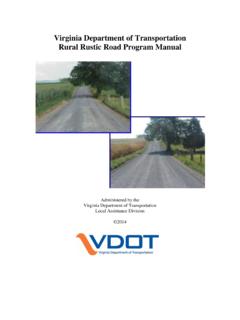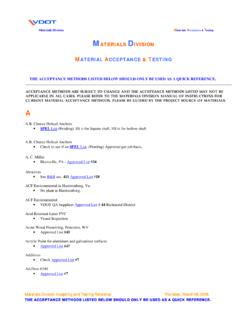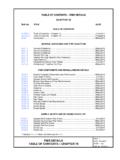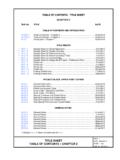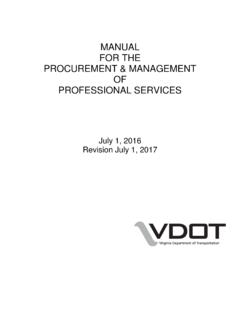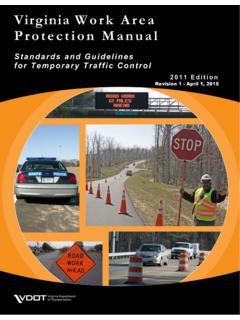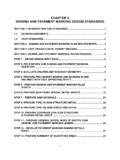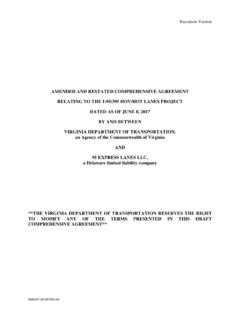Transcription of Chapter 10 - Erosion and Sediment Control
1 vdot Drainage Manual 10-i Chapter 10 E & S Control Chapter 10 - Erosion and Sediment Control TABLE OF CONTENTS Chapter 10 - Erosion AND Sediment Control .. 10-1 Introduction .. 10-1 Objective .. 10-1 Principal Factors Influencing Erosion .. 10-1 Soil Characteristics ..10-1 Vegetative Cover ..10-2 Topography ..10-2 Climate ..10-2 Design Policy .. 10-3 Federal Policy .. 10-3 State Policy .. 10-3 DEQ Certfications ..10-6 vdot Training/Certifications ..10-8 Policy/General Guidelines ..10-9 Documentation .. 10-11 Design Documentation .. 10-11 Minimum Requirements for All ESC Plans .. 10-11 ESC Plan Development Process .. 10-12 SWPPP Applicability and Requirements .. 10-20 Form LD-445E .. 10-21 SWPPP General Information Sheets .. 10-22 SWPPP Documents .. 10-24 SWPPP Components .. 10-25 Computations .. 10-30 Field Revisions and Evaluations .. 10-31 Maintenance .. 10-32 Standard Forms .. 10-32 References .. 10-33 List of Appendices Appendix 10B-1 Erosion and Sediment Control Plan Details Appendix 10C-1 Erosion and Sediment Control Plan Example No Plan Project vdot Drainage Manual 10-1 of 33 Chapter 10 E & S Control Chapter 10 - Erosion and Sediment Control Introduction Erosion and sedimentation are natural or geologic processes whereby soil materials are detached and transported from one location and deposited in another, primarily due to rainfall and runoff.
2 Accelerated Erosion and sedimentation can occur at times in conjunction with highway and transportation facility construction. This accelerated process can result in significant impacts such as safety hazards, expensive maintenance problems, unsightly conditions, instability of slopes, and disruption of ecosystems. For this reason, the total design process must be done with consideration given to minimization of Erosion and sedimentation. Objective The purpose of Erosion reassessing and Sediment Control is to provide an effective plan to Control soil Erosion and prevent Sediment from leaving the construction site . The Department s annually approved Erosion and Sediment Control and stormwater management standards and specifications. Additional information can be found in the Virginia Erosion and Sediment Control Handbook and the Virginia Erosion and Sediment Control Regulations.
3 This Handbook can be ordered from the Virginia Department of Environmental Quality at (804) 698-4000, or can be found at the website: .* The Virginia Erosion and Sediment Control Regulations can be access from the website, #C0840 Principal Factors Influencing Erosion Soil Characteristics The properties of soil which influence Erosion by rainfall and runoff are ones which affect the infiltration capacity of a soil and those which affect the resistance of soil particles be detached and carried away by falling or flowing water. Soils containing high percentages of fine sands and silt are normally the most erodible. As the clay and organic matter content of these soils increases, the potential for Erosion decreases. Clays act as a binder to soil particles, thus reducing the potential for Erosion . However, while clays have a tendency to resist Erosion , once eroded they are easily transported by water.
4 Soils high in organic matter have a more stable structure which improves their permeability. Such soils resist raindrop detachment and infiltrate more rainwater. Clear, well-drained, and well-graded gravels and gravel-sand mixtures are usually the least erodible soils. Soils with high infiltration rates and permeabilities reduce the amount of runoff. * Rev 7/14 Introduction Chapter 10 E & S Control 10-2 of 33 vdot Drainage Manual Vegetative Cover Vegetative cover plays an important role in controlling Erosion in the following ways: Shields the soil surface from the impact of falling rain Holds soil particles in place Maintains the soil's capacity to absorb water Slows the velocity of runoff Removes subsurface water between rainfalls through the process of evapo-transpiration By limiting and staging the removal of existing vegetation, and by decreasing the area and duration of exposure, soil Erosion , and sedimentation can be significantly reduced.
5 Special consideration should be given to the maintenance of existing vegetative cover on areas of high Erosion potential such as erodible soils, steep slopes, drainage ways, and the banks of streams. Topography The size, shape, and slope characteristics of a watershed influence the amount and rate of runoff. As both slope length and gradient increase, the rate of runoff increases and the potential for Erosion is increased. Slope orientation can also be a factor in determining Erosion potential. Climate The frequency, intensity, and duration of rainfall are fundamental factors in determining the amounts of runoff produced in a given area. As both the volume and velocity of runoff increase, the capacity of runoff to detach and transport soil particles also increases. Where storms are frequent, intense, or of long duration, Erosion risks are high. Seasonal changes in temperature, as well as variations in rainfall, help to define the high Erosion risk period of the year.
6 When precipitation falls as snow, no Erosion will take place. However, in the spring the melting snow adds to the runoff and Erosion hazards are high. Because the ground is still partially frozen, its ability to absorb runoff is reduced. Frozen soils are relatively Erosion -resistant. However, soils with high moisture content are subject to uplift by freezing action, and are usually very easily eroded upon thawing. Design Policy vdot Drainage Manual 10-3 of 33 Chapter 10 E & S Control Design Policy A policy for Erosion and Sediment Control is stated in the American Association of State Highway Transportation Officials' publication, "A Policy on Geometric Design of Rural Highways," as follows: " Erosion prevention is one of the major factors in the design, construction, and maintenance of highways. Erosion can be controlled to a considerable degree by geometric design particularly relating to the cross section.
7 In some respects the Control is directly associated with proper provision for drainage and fitting landscape development. Effect on Erosion should be considered in the location and design stages." " Erosion and maintenance are minimized largely by the use of flat side slopes, rounded and blended with natural terrain; drainage channels designed with due regard to width, depth, slopes, alignment and protective treatment; located and spaced facilities for ground water interception; dikes, berms and other protective devices; and protective ground covers and planting." Federal Policy As a result of the National Environmental Policy Act of 1969 and the Chesapeake Bay Protection Act, much attention has been directed to the Control of Erosion and sedimentation. As a result of this concern, numerous state and federal regulations and controls governing land disturbing activities have been developed and published.
8 Federal Control requirements are enforced by numerous agencies such as the Corps of Engineers (COE), Department of Conservation and Recreation (DCR), Environmental Protection Agency (EPA), Fish and Wildlife Service (FWS), etcetera, through their administration of various permitting requirements (Section 404, Section 402 of the Federal Water Pollution Control Act (FWPCA), and Section 9 and 10 of the River and Harbor Act). State Policy The Department of Environmental Quality* annually reviews and approves vdot s Erosion and Sediment Control Program. This Annual review includes all of vdot s Erosion and Sediment Control standards, specifications, policies, and design guidelines as outlined in the Road and Bridge Standards, Road and Bridge Specifications, Drainage Manual, Road Design Manual, Instructional and Informational Memoranda, and other associated directives.
9 vdot receives an annual approval of its ESC Standards and Specifications from DEQ. * Rev 7/16 Design Policy Chapter 10 E & S Control 10-4 of 33 vdot Drainage Manual By its annual approval of vdot s ESC Standards and Specifications, DEQ authorizes vdot to administer its ESC Program in accordance with the Approved ESC Standards and Specifications, on all regulated land disturbance activities undertaken by the Department*. vdot s approved ESC Standards and Specifications shall apply to all plan design, construction and maintenance activities undertaken by vdot , either by its internal workforce or contracted to external entities, where such activities are regulated by the Virginia ESC Law and Regulations. During any inspections of vdot land disturbing activities by DEQ, EPA and other such environmental agencies, compliance with the vdot s Approved ESC Standards and Specifications (and all parts thereof) will be expected.
10 A standard, specification or product not contained or referenced in vdot s Approved ESC Standards and Specifications cannot be used unless it is submitted to and approved by DEQ either as a revision to the Approved ESC Standards and Specifications or a project specific variance. Statewide use of standards, specifications or products not contained in vdot s DEQ Approved ESC Standards and Specifications will require a revision to the Approved ESC Standards and Specifications. Any revisions to the Approved ESC Standards and Specifications shall be reviewed and approved by DEQ prior to implementation by vdot . Such review and approval shall be coordinated by the vdot State Stormwater Program Administrator in the vdot Central Office with the DEQ Regulatory Programs Manager in the DEQ Central Office Stormwater Management Division. Where determined necessary to meet an individual project need, vdot may request DEQ to grant a project specific variance to the Approved ESC Standards and Specifications: All requests for project specific variances for those projects being designed in a vdot District Office shall be coordinated by the District Hydraulics Engineer with the appropriate DEQ Regional Office staff.
